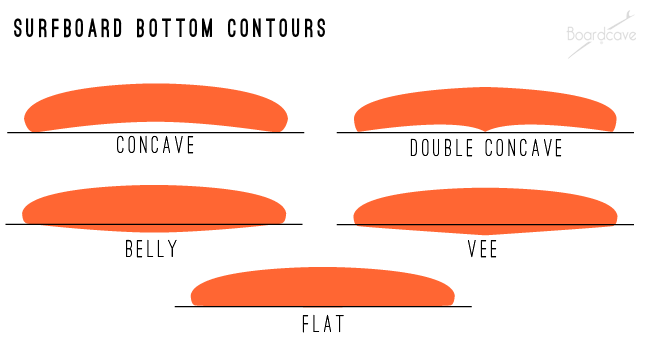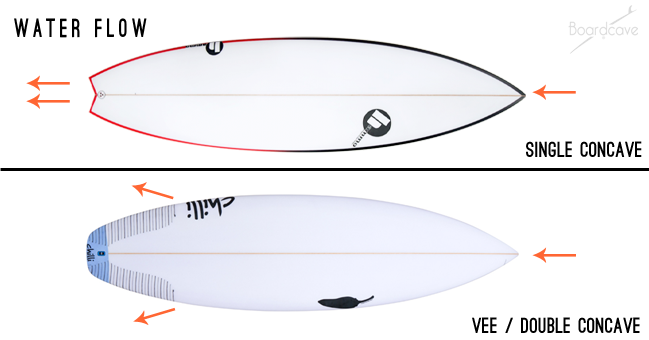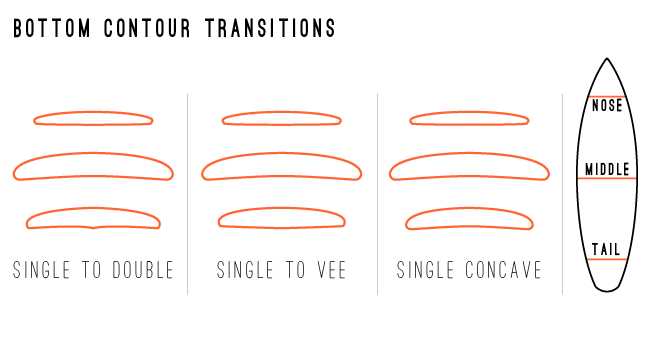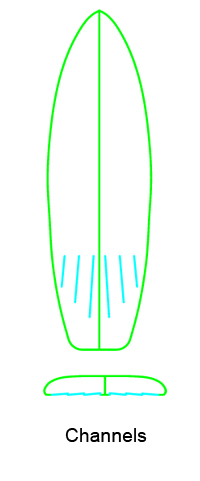板底輪廓不同的設計可以用來導引水的流動而達成技巧花招穩定性、展現性及速度等目的,靠著透過板底長度導引水的流動將會影響板子的表現,不同板底輪廓設計有著廣泛的運用,以下是的主要設計

Flat Bottom平底
平板底有著刨成平的表面,是一個可以有效率的在水面上滑行的設計,當他拍打浪面卻不會離開水面,板子會快速,鬆散且有反應力在小浪及軟浪上,然而他在大浪及快速行徑時較不穩定,他的平底將會導致難以開啟轉彎即當轉彎時經常性地滑出去。
BellyBottom凸肚板底
腹部底有著凸的刨面,大部分現的都設計在靠板頭前面1/3處,當拍打浪面時不像平底,凸面會離開水面,這是為了控制的設計,可以在較亂的浪況下有著較流暢的起乘,在快速或大浪下可以較簡單的轉動,也就說較易於傾斜來做Rail to Rail的招式
Concave Bottom凹槽底
凹陷刨面目的是使水流直線流過板底而不讓水從板緣跑掉。水會從寬的地方由板尾窄的地方經過FIN處,也就是板尾一帶被擠壓出來。水流產生壓力使得板子有多一些升力,而降低阻力。同樣地透過在浪上的轉彎或迴旋,靠著壓縮水及朝向板尾將水擠壓出來,這讓板子的加速性更為突顯。
Channel Bottom管溝板底
這形狀通常多為由2到8個互相平行的管溝槽靠板底處所組成,管溝驅使更多的水穿過板子而轉換成水流產生往前的推進力。
Vee Bottom V板底
V也是突起刨面,典型的設計大多在板子後方算起1/3處,有點像凸肚板底設計(Belly Bottom),它發生作用在rail to rail迴旋點的衝浪方式上。因為這設計大多用在板尾的地方,當在高速時,它會使的板尾有更多的反應力。它也是向其他凸面設計一樣,水流從板尾邊緣流失後而失去能量。會使的板子在小浪及亂浪中跑動起來變的沒有效率,這設計適合在比起速度更需要控制力的大浪及快浪下。


Channel Bottoms
Like concaves, channel bottoms are designed, in theory, to direct water flow from nose to tail and in doing so, generate more drive and speed. They may also facilitate some ventilation or introduce some boundary layer turbulence, depending on their shape and length. But unlike concaves, channels do not alter rocker in any significant manner. Rather, channels are simply wedge shaped grooves shaped into the existing bottom of the board, whether it be flat, concave or (rarely) convex. The channels are most often toed in at the same angle as the rail fins, and may be uniform in width, or flared slightly from entry to exit. Typically 4 to 8 grooves are shaped into the bottom of the board through the tail section only, although some channel bottoms can begin to fade in at about the middle of the board. The long and deeper the channels, the more their effects are felt. The channels may fade out behind the trailing fin, or may run right off the tail rails and out the tail block. The trailing fin most often sits on the peak created by the two centermost channels, and the rail fins may sit within a channel, or on the edge of a channel.
Most commonly used on boards for small to medium surf, channel bottoms are effective in creating more hold and drive, but at speed have a tendency to become tracky. To compensate for this trackiness would require accelerated rocker, smaller fins, or a narrower tail, all of which would effectively undo what small wave boards are designed to do – plane higher, flatter and faster in weak or small surf. Still, channels do provide excellent hold on steep sections, conserve speed through turns, and add heaps of drive, and so modest accommodations can be made: smaller fins and (because bottom channels, like rail channels, tend to stiffen a board) a touch more rocker are common combinations with this design.
Single to Double Concave
Most modern performance thrusters use some kind of single to double concave setup, where the single concave is shaped first, and the double is shaped within the single. This puts the bottom rail edge lower than the stringer throughout the entire concave array. Typically, the single concave starts 12-18 inches from the tip of the nose, gradually deepening until it reaches its maximum depth somewhere between the wide point of the board and the midpoint between the wide point and the leading edge of the rail fins. The single then gradually fades out to flat or vee behind the trailing edge of the center fin. The double concaves can begin anywhere, but typically begin to fade in at the point where the single concave is deepest. The double concaves are usually deepest near the leading edge of the rail fins, then either quickly fade to flat or vee at the trailing edge of the center fin, or are run right out the tail block, the latter being more common on fish type boards. Many riders report that changing the length of the double concaves changes the feel of the board – lengthening the doubles gives a greater sense of control at speed and added drive. Shortening the doubles gives a greater sense of lift and responsiveness, but a lesser degree of control at speed. This might be explained by the fact that the further forward the doubles extend, the more the flow of water coming through the single concave is kept separated, reducing the turbulence caused by flow convergence as the template narrows.
